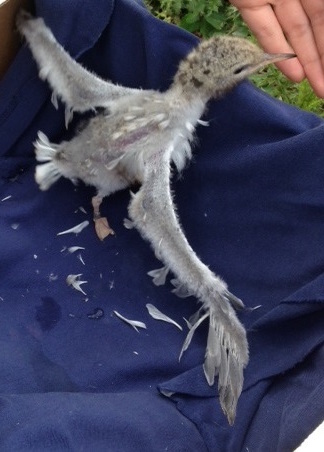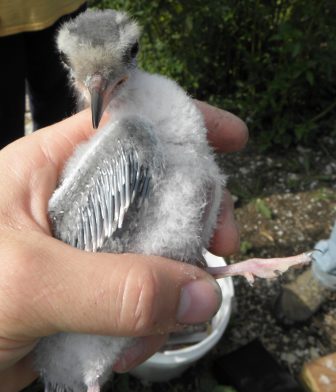
Chick suffering premature feather loss. Image: Jennifer Arnold
By Eric Freedman
We’re told that birds of a feather flock together.
But what happens when flocks of birds lose their feathers?
Scientists are puzzling over a rare occurrence: premature feather loss among common tern chicks at Gull Island in northern Lake Ontario, Canada.
The July 2014 discovery was the first known occurrence of premature feather loss among terns in 40 years, a new study said, and “was largely of unknown origin.”
The phenomenon affected about 5 percent of tern chicks that were banded that season.
Usually, chicks don’t start to molt until 4 to 7 months after they fledge — meaning when they’re old enough to fly. Feather loss before fledging isn’t part of their normal development.
The birds that lost their feathers were 2 to 4 weeks old, and they fledged 10 to 20 days later than normal, said the study, which called it an “enigmatic developmental anomaly.”
“Complete feather loss from all body areas — wing, tail, head and body — occurred over a period of a few days, but all affected chicks appeared vigorous and quickly began to grow replacement feathers,” the study said.
Lead author Jennifer Arnold of Penn State University’s Berks campus put it more colorfully: “The birds over a couple of days looked like plucked chickens and were denuded of their feathers.”
Meanwhile, the research team has just discovered a recurrence of the phenomenon this summer, Arnold said, although it affected a smaller proportion of this season’s chicks.
The scientists identified the phenomenon while banding chicks as part of a long-term research project, started in 2008, that’s intended to get a better idea of the challenges confronting common terms’ survival. It’s also meant to develop management strategies, including anti-predator measures, to protect them.
“Common terns are declining in the inland regions of North America,” Arnold said.

Chick with some feathers regrowing. Image: Stephen Oswald
They’re classified as an endangered species in the Great Lakes states, but have no at-risk protection yet in Canada.
The cause of the feather loss remains a mystery, according to the team from Penn State, Presq’ile Provincial Park, where Gull Island is located, and the National Wildlife Research Centre in Ottawa.
Gull Island is home to the last persistent significant breeding colony on the lower Great Lakes. According to Arnold, the island historically was a “stronghold with really, really large numbers” of common terns but the population is now estimated at only a little more than 100 breeding pairs. By contrast, coastal colonies are doing well.
Typical causes of feather loss among common terns include nutritional deficiencies, shock, pecking and starvation, but in this case, the premature feather loss coincided with “persistent southwesterly winds that caused extensive mixing of near-shore surface water with cool, deep lake waters,” according to the study published in the journal PEERJ.
That could have exposed them to “as-yet unknown toxins or pathogens,” the study said.
Unknown pathogens or toxins still remain a possible cause, Arnold said, but may not be weather-related because of differences in 2014 and 2016 weather patterns.
So what happens to the affected birds? The researchers found no developmental abnormalities such as crossed bills or reformed limbs, but they did find shorter wings and tails than same-aged normally feathered chicks had.
However, it took them about twice as long to fledge — to be able to fly– than chicks that hadn’t lost their feathers.
And such a delay means their parents expend more energy to gather food, while leaving them more vulnerable to predators, according to Arnold.
The study said the Gull Island occurrence and other recent feather loss occurrences elsewhere involving penguins and gulls “may, perhaps indicate widespread environmental changes that could lead to health risks for birds and other wildlife, especially if pathogenic organisms are responsible.”